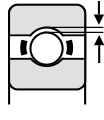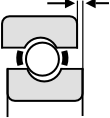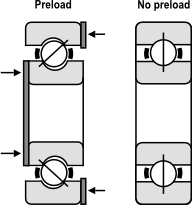Internal clearance or radial play is the amount of looseness between the balls and raceways of a bearing.
For the actual clearances used in the radial play groups, please see our RADIAL PLAY TABLES
 Radial play is the clearance measured perpendicular to the bearing axis or more specifically: average outer ring raceway diameter minus average inner ring raceway diameter minus (2 x ball diameter).
Radial play is the clearance measured perpendicular to the bearing axis or more specifically: average outer ring raceway diameter minus average inner ring raceway diameter minus (2 x ball diameter).
 Axial play is the clearance measured along the bearing axis is known as axial play. Axial play is approximately 10 times the radial play value.
Axial play is the clearance measured along the bearing axis is known as axial play. Axial play is approximately 10 times the radial play value.
The radial play in the bearing before it is fitted can be called the "initial" radial play. "Residual" or "operational" radial play is what is left when the bearing has been fitted. In most cases, there should be almost zero residual radial play in the bearing to minimize ball skidding and reduce axial play (end play). A large residual radial play may be desirable to cope with temperature differences, misalignment or a higher axial load. Correct selection of radial play is important for maximising bearing life.
A number of things can alter the radial play during the fitting process. A tight shaft fit where the shaft is slightly larger than the bearing inner ring (often called an interference fit or a press fit) will stretch the inner ring so making it bigger. This reduces radial play by up to 80% of the interference fit. A similar thing occurs if the outer ring is a tight fit in the housing. A difference between the shaft and housing temperatures can also be a problem. If a bearing inner ring gets hotter than the outer ring, it will expand more and reduce radial play. This can be calculated as follows:
Chrome Steel: 0.0000125 x (inner ring temp - outer ring temp °C) x outer ring raceway diameter* in mm.
440 Stainless Steel: 0.0000103 x (inner ring temp - outer ring temp °C) x outer ring raceway diameter* in mm.
* The outer ring raceway diameter can be roughly calculated as: 0.2 x (d + 4D) where d is the bore in mm and D is the outer diameter in mm.
There can also be problems where, for example, the shaft is made of different material to the bearing and housing and expands more due to a different expansion coefficient. In such a case, a bearing with a looser radial play may be needed.
A standard radial play is usually suitable and these bearings are more readily available but, sometimes, a non-standard clearance is recommended. A tight radial play is better for low noise, greater rigidity and running accuracy if the load is purely radial. A loose radial play is preferable for high axial loads as it increases the bearing's axial load capacity. It will also better accommodate misalignment between the shaft and housing.
Tight Radial Play (MC1/MC2, PO2/P13, C2): Consider for pure radial loads and low noise, low vibration applications. Beware of axial loads, high speed applications, heavy vibration and very low torque applications. Interference fits should not be used.
Medium Radial Play (MC3/MC4, P24/P35, CN): Most commonly used and supplied as standard except for full ceramic bearings which have C3 as standard.
Loose Radial Play (MC5/MC6, P58/P811, C3/C4): Consider for higher axial loads due to greater thrust load capacity. Greater interference fits and shaft misalignment can be tolerated. Also good for heavy or shock loads. Not recommended for low noise applications unless tighter radial play not suitable.
Radial play has nothing to do with precision grade or tolerance. A loose bearing does not necessarily mean a low precision bearing. You can have a P4 (Abec7) grade bearing with a loose radial play just as you can have a P0 (Abec1) bearing with a tight radial play so too much play suggests a tighter radial play or an axial preload is needed.

In low noise or high speed applications, zero residual radial play is desirable. This gives greater rigidity, reduces noise, gives greater running accuracy and can eliminate ball skidding under acceleration. This is achieved by applying a preload to the bearing. This is an axial load applied to the inner or outer ring to offset the outer ring against the inner ring and eliminate radial play.
Preload is usually applied by the use of wave or spring washers and normally to the stationary ring which should have a sliding fit to the shaft or housing to allow for axial movement. If the bearings are glued on to the shaft or housing, it may be possible to use weights to keep the bearing preloaded while the adhesive cures. The amount of preload should be as small as possible. Excessive preload can cause high frictional torque and rapid failure.
The following guide to preloads is provided by Sapporo Precision
|
Preload Category |
Preload Amount Miniature & Small Bearing (Cr = Basic Dynamic Load Rating) |
Preload Amount Standard Bearing (Cr = Basic Dynamic Load Rating) |
Features |
| Slight Preload | 0.50% x Cr | 0.15% x Cr | Bearing rigidity not required. Emphasis on low torque. |
| Light Preload | 1.25% x Cr | 0.58% x Cr | Bearing rigidity and low torque both required. |
| Medium Preload | 1.75% x Cr | 1.28% x Cr | Emphasis on bearing rigidity. Relatively high torque. |
| Heavy Preload | 2.50% x Cr | 2.64% x Cr | Emphasis on bearing rigidity. High torque. |
